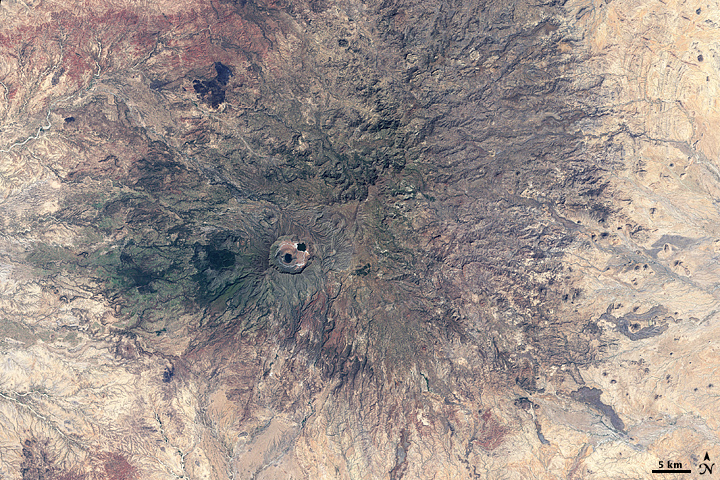
Mt. Marra, Sudan
Downloads
- mtmarra_l7_2001316_lrg.jpg (4000x4000, JPEG)
- mtmarra_l7_12nov01_crop_geo.tif (4000x4000, GeoTIFF)
- ge_36692.kml (KML)
Metadata
- Sensor(s):
- Landsat 7 - ETM+
- Data Date: November 12, 2001
- Visualization Date: January 16, 2009
The African nation of Sudan extends from the Sahara Desert in the north, where annual precipitation averages 25 millimeters (0.98 inches) to fertile equatorial regions in the south, with annual precipitation of over 1,600 millimeters (63 inches). Halfway though this north-south trajectory, in western Sudan, lies a network of volcanic mountains and fertile valleys where just enough rain falls to sustain agriculture. This mountainous region contains a volcanic field known as Jebel Marra.
The Enhanced Thematic Mapper Plus on NASA’s Landsat 7 satellite acquired this natural-color image of Jebel Marra on November 12, 2001. Ancient eruptions have formed dark rivulets of rock that flow downhill away from the summit. At the summit is Deriba Caldera. The crater formed when an eruption of pumice and pyroclastic flows—avalanches of scalding gas, rocks, and volcanic debris—removed rock material from under the volcano’s summit about 3,500 years ago. Two lakes have formed in the crater, and may be supplied by hot springs as well as rainfall. Volcanologists consider this volcano dormant but not extinct.
The land surface visible in this image consists of a combination of barren rock, especially east of the summit, and vegetation, especially west of the summit. The deep green patches suggest dense vegetation, but most of the green areas in this image consist of fairly sparse plant life. The dark color of the volcanic rock makes the vegetation seem lusher than it really is. On the slopes and in the nearby foothills, the land enjoys just enough precipitation to support rain-fed agriculture and grazing. An influx of refugees from the Darfur conflict and increased cattle grazing, however, led to deforestation in the late twentieth and early twenty-first centuries.
References
- Earth Observatory. (2008, October 29). Deriba Caldera. NASA. Accessed January 9, 2009.
- Global Volcanism Program. Jebel Marra. Smithsonian Institution. Accessed January 9, 2009.
- United Nations Environment Programme. (2008). Africa: Atlas of Our Changing Environment. Division of Early Warning and Assessment, United Nations Environment Programme, Nairobi, Kenya.
NASA image created by Jesse Allen, using Landsat data provided by the United States Geological Survey. Caption by Michon Scott.
This image record originally appeared on the Earth Observatory. Click here to view the full, original record.